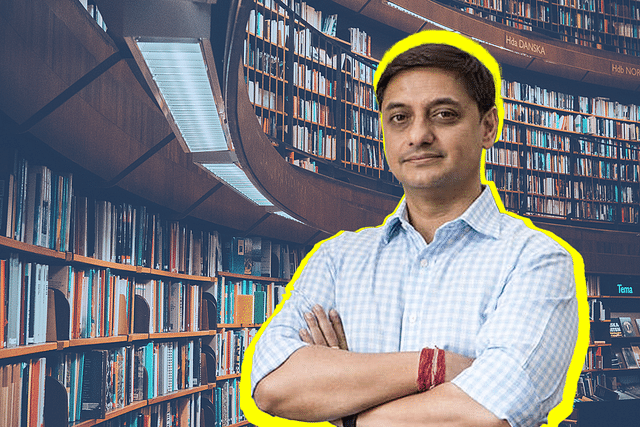Ideas
Reduce Load In Few Key Areas, Declog Judicial System For All: Sanjeev Sanyal And Co-Author's Prescription
Abhay Rathore
Sep 13, 2023, 07:47 PM | Updated 09:08 PM IST
Save & read from anywhere!
Bookmark stories for easy access on any device or the Swarajya app.

Throughout the hierarchies of India's judicial system, there are approximately 52 million pending cases.
In an article published in The Economic Times, Sanjeev Sanyal, a member of the Economic Advisory Council of the Prime Minister, and his co-author, Jayasimha KR, delve into this critical issue by examining the cumulative numbers of cases where the central or state governments, or related agencies are the litigators.
The dataset used for this exercise was the Legal Information Management and Briefing System— an online repository of GoI's court cases.
Sanyal and his co-author point out that currently, there is a striking backlog of around 44.7 million cases pending in district and taluk courts, 60.64 lakh awaiting attention in High Courts, and a relatively modest 69,000 clamouring for justice in the halls of the Supreme Court.
What's alarming according to them, however, is the undeniable role played by the government, both at the central and state levels, along with state-affiliated agencies in contributing to this congestion, as mentioned by various law commission reports.
Citing data from the LIMBS repository, the authors note that a handful of ministries and statutory institutions contribute for a large percentage of the cases. The top five being the Ministries of Finance, Railways, Defence, Labour, and the Comptroller and Auditor General (CAG), collectively accounting for approximately 75 per cent of pending litigation involving the GoI in India's courts.
The Ministry of Finance leads the pack with around 27 per cent of the pending cases, followed by the Railway Ministry (17 per cent), Defence Ministry (13 per cent), Labour and Employment Ministry (12 per cent), and the CAG (3 per cent).
Furthermore, around 42 per cent of cases in the Ministries of Finance and Defence have are over five years old. This trend is echoed in 55 per cent of railway cases, 49 per cent of labour and employment cases, and 36 per cent of CAG-related cases.
The LIMBS database categorizes these cases into 12 types. Out of these, tax-related issues make up 28 per cent, while service matters account for 22 per cent. Miscellaneous cases, including special leave petitions, constitute 17 per cent, followed by labor disputes at 10 per cent, and land-related matters at 8 per cent.
He points out that of the 6,45,000 active cases in LIMBS, 9 per cent are waiting for resolution in district and session courts, 37 per cent in high courts, 40 per cent in tribunals, more than 9 per cent in other courts (like revenue courts), and over 2 per cent in the Supreme Court (SC).
Sanyal and Jayasimha note that tribunals and HCs carry the majority of the Government of India's legal backlog. For example, 55 per cent of the Finance Ministry's cases are stuck in tribunals, and 37 per cent are in HCs. Similarly, for Railways, 48 per cent of cases are in various tribunals, and 23 per cent are before HCs. Defence is also grappling with a backlog, as 65 per cent of its cases await resolution in tribunals.
The authors highlight that In the Economic Survey of 2017-18, Chapter 9 studied how often tax departments won their cases in tribunals, high courts, and the Supreme Court.
The also found that a very small fraction, just 0.2 per cent, of cases represented a significant 56 per cent of the total money at stake. Meanwhile, 66 per cent of the cases with claims below 10 lakh made up only 1.8 per cent of the total money tied up in pending cases.
In layman's terms, a lot of the cases causing delays didn't involve substantial economic sum at the level of the entire state machinery. Therefore, the authors believe that it is essential to conduct a new analysis to understand the current situation better.
In the same Economic Survey, it was found that the tax department didn't win most of its cases in tribunals, high courts, and the Supreme Court. They had a success rate of less than 30 per cent, and lost 65 per cent of their cases.
Furthermore, in May, a Supreme Court panel mentioned that about 40 per cent of government lawsuits, from both the central and state governments, seemed to be unimportant or "frivolous."
According to Sanyal and Jayasimha, this problem has been around for a while. The Law Commission of India talked about the need to decrease government lawsuits in its 100th report in 1984, 126th report in 1988, and 230th report in 2009. Similarly, the Second Administrative Reforms Commission discussed this issue in its Fourth Report in 2007.
The authors conclude by pointing out that although the LIMBS database is useful for understanding GoI's legal cases, there's a need to conduct a similar analysis for other government levels to fully address the problem. They believe that since the bulk of the problem is concentrated in a few departments, if the load in few key areas is reduced, it would clear the backlog to a great extent.
Save & read from anywhere!
Bookmark stories for easy access on any device or the Swarajya app.
Support Swarajya's 50 Ground Reports Project & Sponsor A Story
Every general election Swarajya does a 50 ground reports project.
Aimed only at serious readers and those who appreciate the nuances of political undercurrents, the project provides a sense of India's electoral landscape. As you know, these reports are produced after considerable investment of travel, time and effort on the ground.
This time too we've kicked off the project in style and have covered over 30 constituencies already. If you're someone who appreciates such work and have enjoyed our coverage please consider sponsoring a ground report for just Rs 2999 to Rs 19,999 - it goes a long way in helping us produce more quality reportage.
You can also back this project by becoming a subscriber for as little as Rs 999 - so do click on this links and choose a plan that suits you and back us.
Click below to contribute.





